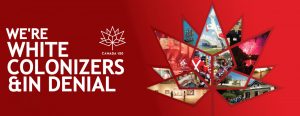
This ad intends to promote a campaign by the Canadian federal government to celebrate the 150th anniversary of the confederation of Canada in 2017. Some celebrations included a travelling red couch, free National Parks passes, and displays of Canadian art, as well as many smaller community-based events. This advertisement, featuring the text “We’re red white & true,” aims invoke a sense of patriotism in the viewer, using the colours of the Canadian flag. The ad is problematic for a few reasons, including the insinuation that there is only 150 years of history of the land Canada sits on, the use of the word ‘red’ given the creators and targets of the ad, and the lack of representation of Indigeneity in the imagery.
Historically, ‘red’ has been used to derogatorily describe Indigenous people, and has its roots in early colonial history. The advertisement uses it to describe the entirety of Canadians, most of which are settlers. Using the word as a positive descriptor in a celebration of colonialism is not only in poor taste, but contributes to the erasure of Indigenous people in Canadian history and contemporary society. Using it to describe Canadians as a whole erases the word’s violent history. In addition, it is the federal government that launched the Canada 150 campaign; the same federal government that continues to contribute to colonial violence against Indigenous people, which adds weight to this appropriation of ‘red’.
One major criticism of the Canada 150 campaign in its entirety has been that it implies that the land on which Canada sits has only 150 years of history. While some attempt to acknowledge the extensive history of the First Nations has been made, reflected in the ad in the singular image of an Indigenous person performing a traditional dance framed within the maple leaf, it falls short. Instead, the ad serves as another example of how Canadians continue to sweep a violent history under the rug.

By replacing the language in the advertisement, I have highlighted those who have benefited from 150 years of confederacy, namely white settlers, and point out that many of these people choose to ignore the ways in which they contribute to ongoing colonial violence.
Canada 150 is a campaign by the Canadian federal government, a colonial institution, in which a mere 3% of representatives are Indigenous (Wolfe, 2015). The altered advertisement reflects this by replacing the “red” and “white” in the original ad with “white” and “colonizers.”
Many Canadians turn a blind eye to how their occupation of traditional, stolen territory continues to affect Indigenous communities. The residential school system, implemented by the government of Canada, has caused intergenerational effects of trauma, which we can see today in disproportionately high rates of mental illness, suicide, and addiction within Indigenous communities (Stephens, Nettleton, Porter, Willis, & Clark, 2005). Additionally, some would argue that the residential school system is perpetuated today in the foster care system, where there is an overrepresentation of Indigenous youth, who are removed from their communities to be raised in primarily white households (Trocmé, Knoke, & Blackstock, 2004). On top of this, Indigenous people face additional challenges accessing government resources such as health care (Tang & Browne, 2008). Canadians are “in denial” about these direct ways that government systems continually contribute to oppressing Indigenous people.
The original ad uses large, bulky font in order to invoke a strong sense of patriotism and solidarity among viewers. In my altered ad, I use the same large font in order to mimic these feelings, but induce dissonance by describing white Canadians as “colonizers” and “in denial.” This dissonance might be enough to drive viewers to reflect more deeply on the concept of Canada 150, and whose histories we are and aren’t celebrating through it. I left the images within the maple leaf the same as they reflect the altered message: the people featured in the photos are overwhelmingly white, with one exception. Additionally, I think that the framing of an image of Mounties, workers of a system that is fundamentally rooted in colonialism, next to an Indigenous person performing a traditional dance emphasizes the divide between the two groups.
References
Stephens, C., Nettleton, C., Porter, J., Willis, R., & Clark, S. (2005). Indigenous peoples’ health—why are they behind everyone, everywhere?. The Lancet, 366(9479), 10-13.
Tang, S. Y., & Browne, A. J. (2008). ‘Race’matters: racialization and egalitarian discourses involving Aboriginal people in the Canadian health care context. Ethnicity and Health, 13(2), 109-127.
Trocmé, N., Knoke, D., & Blackstock, C. (2004). Pathways to the overrepresentation of Aboriginal children in Canada’s child welfare system. Social Service Review, 78(4), 577-600.
Wolfe, N. (2015, October 22). Canada’s new parliament is the most diverse ever. The Guardian. Retrieved from https://www.theguardian.com/world/2015/oct/22/canada-new-parliament-most-diverse-ever